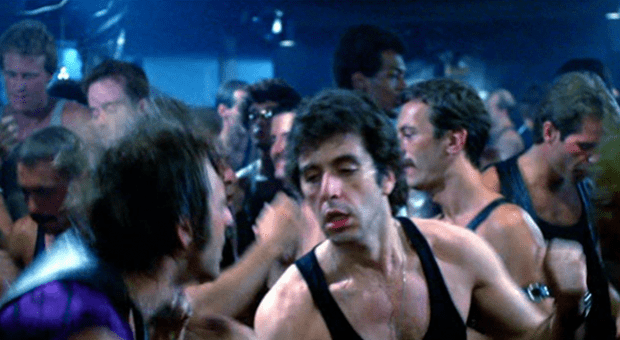Cruising might be “the least naive and the least condescending mainstream movie about gay men ever made,” proclaims screenwriter and novelist Bret Easton Ellis.
Ellis is speaking of William Friedkin’s 1980 psychological thriller about a serial murderer preying on gay leathermen in late-1970s New York.
The film, starring Al Pacino, panned critically but was a modest success at the box office and sparked a massive outcry from the gay community.
“Some of the tough-guy dialogue is stilted and flatly delivered and there are awkward directorial choices, but the punk minimalism is infused with a gritty lurid dread, and Cruising ultimately becomes a very quiet, muted art-house movie about masculinity and identity,” Ellis writes.
Ellis has chosen Cruising as one of six films is his Film Comment article entitled “Guilty Pleasures.” “Films made by famous directors that I genuinely like but that I feel got shafted in terms of their initial reputations, so this is not about me defending my love of bad movies,” he writes.
“[But] I don’t believe in the idea of guilty pleasures because I don’t think you should feel guilty about liking anything.”
The other five films on his list are 1941, The Fog, Stardust Memories, Something Wild and Greenberg.
In Cruising, Pacino plays cop Steve Burns and disappears into New York’s underground scene of BDSM clubs and leather bars in the then-notorious Meatpacking District — bait to lure the killer, as Pacino looks like the victims.
“It’s about taking on a role, preparing for a part, and losing yourself to a character. It has an open and neutral exploratory quality, though there’s an interesting disparity between the cops, in the brightly lit precinct scenes, enacting their own miserable S&M punishments on suspects, and the guys in the violet-hued underground bars playing out their rapturous rituals of pain and desire with one another,” Ellis writes.
When shooting for Cruising began in New York in the summer of 1979, the gay community responded with street protests and organized attempts to interfere with the location shoots. One protest through the East Village drew more than 1,000 marchers.
“Yes, it was viewed as a provocation, but it was also fatally misunderstood by the gay community, which slammed it at the time. It’s just a murder mystery set on the fringes of the gay S&M world—it’s not an indictment of anything, and the gay men in the movie are remarkably varied and unstereotypical. The final scenes are deeply ambiguous and unnerving,” Ellis writes.


 Why you can trust Xtra
Why you can trust Xtra


